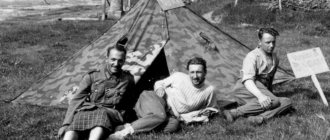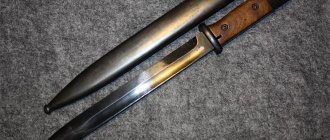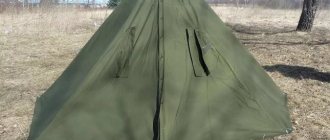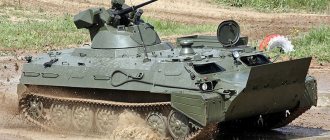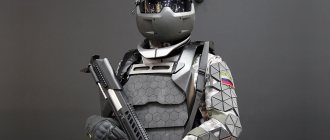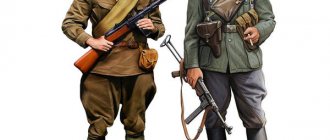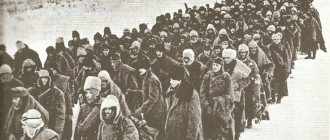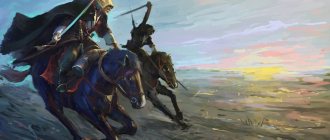Raincoat tents (English: waterproof cape) are wearable camping tent items intended for one person. The material for their execution, as a rule, is waterproof fabric, which simultaneously plays the role of both a raincoat and a tent. In case of special need, they can also be used as stretchers or drags for transporting soldiers wounded in battle or sick.
The history of the creation of the first models
The first raincoat was invented back in the 18th century. The exact history of its origin is unknown, although historians claim that since 1882 it has become an integral part of military equipment. For those times, the creation of an individual army raincoat became a real salvation from inclement weather. According to the regulations, soldiers' raincoats were transported in a second-class convoy.
He walked behind at a distance equal to half a day's journey. That is, we had to wait for a place to sleep until late at night or in the morning. Individual products gave soldiers the opportunity not to wait for arrival and create shelter from inclement weather from a raincoat. At first, the raincoat-tents were fastened behind the back in the form of a bundle. Over time, the soldiers adapted to shelter her on the way.
Noticing the resourcefulness of the army, some of the equipment was modernized. Thus, the soldier's raincoat acquired its main form and name in 1910. After short use, the following disadvantages were noted:
- the front part went down to the knees, so heavy rain wet the trousers;
- the back part, due to its length, was bent and tucked into the belt. As they walked, raindrops dripped down into their boots;
- if the rear corner is not tucked in, it will drag along the ground, rustling annoyingly. After some time, a military man could even lose part of his equipment;
- the fabric was thin and after 3-4 hours it became thoroughly wet.
Raincoat today
The last modernization was in 1910. Since then, the officer's raincoat has not undergone significant adjustments and has retained its appearance until the 21st century.
A modern raincoat has been improved only in terms of fabric quality. It is more durable, water-repellent impregnation is applied to it, and modern coloring allows you to make a reliable and discreet military shelter.
Description and technical data
In addition to the textile fabric, the kit includes:
- laces with a diameter of about 5 mm;
- racks;
- wooden pegs. In production, hard wood species are used, most often birch;
- metal pegs. They can be made from 5 mm steel wire.
The officer's raincoat is made of durable tarpaulin. When folded, it is similar in size to a two-liter plastic bottle. When unfolded, it is a square measuring 1.80 * 1.80 m. Eyelets made of leather or metal are installed along the edges. The weight of the product does not exceed 1.5 kg.
DIY making
With its small dimensions, a raincoat tent can be easily placed even in a small hiking backpack.
Some tourists and travelers try to make a raincoat tent with their own hands, which is quite simple to do:
- Take a piece of thick tarpaulin;
- Can be cut to size 180 by 180 cm or any desired size;
- The fabric can be treated with special water-repellent materials;
- For the hood, special lacing ropes with a diameter of no more than 5 mm with winding at the ends are used;
- The stands are made of wood or steel wire with a diameter of 4 mm.
Although you can make such a raincoat tent in a few evenings, it will not turn out very neat, and you will have to spend a lot of time searching for the necessary materials, so it is easier to buy a ready-made product.
A factory-made cape will weigh only 1.5 kg, and its price fluctuates around 400-600 rubles. It folds up and easily hides in a backpack. Some craftsmen make enlarged versions of the product, claiming that with their help you can shelter several people from bad weather at once, but it’s easier to connect several standard soldier’s tents together, because that’s exactly what they are designed for.
Varieties
Raincoats are available in several variations:
- Frame-deciduous. This is an army product that can be built on site from scrap materials. To do this, you will need branches to create a frame. Then a cloak is placed on the structure, which can additionally be covered with branches with leaves or spruce branches.
- Frame-fabric. Unlike the first option, the fabric is stretched thanks to the included stands, as well as twigs and branches.
- Fabric. To make the products you will need thick waterproof fabric. This can be film, tarpaulin or other rubberized material. The canvas is thrown over a stretched rope, and fixed from below using improvised means.
Description of the classic raincoat
The classic model is a square tarpaulin. There are 4 eyelets in the corners, which are designed for fastening. There are buttons on one side of the cloak, and loops on the other. They are designed to be able to increase in size by connecting several canvases.
A braid was threaded into the cloak, with the help of which a hood was formed in a matter of seconds. They were also used for attaching small but important things to outerwear.
Over time, a button was made on the back, to which the long corner of the cloak was attached.
Soldier's raincoat-tent
This is part of the soldier’s equipment, consisting of square-shaped panels. The standard size is 1.80*1.80 m. They are made of thick cotton fabric, and the kit includes fastening devices. Each canvas can be used by a soldier as a cape, and combining several allows you to create a spacious shelter.
How to assemble correctly
The tent can be set up in several different ways. The chosen option depends on the number of people and the cloths used.
Installation for one person is the simplest. First, the stand is installed. The middle loop of the side of the panel rests on its upper part. A guy is made from a rope so that the cloak stretches in different directions. The four corners are fixed to the soil using pegs or stones.
To install a tent for two people, the canvases are connected to each other. Each canvas becomes a separate roof slope. It is formed by two posts, to which two connected corners of the tent are attached. The free edges are fixed to the soil. The design of a three or four raincoat tent is similar. The difference is that the ends are covered with the third and fourth panels.
For five people, this is a fairly roomy design. The slopes are made up of two sheets each, and only one end is closed. In a design of six panels, both ends are closed, as in four.
Choosing a location for installation
When choosing a location, there are some factors to consider:
- it is recommended to install the structure on a dry surface;
- the open end is located on the leeward side so that slanting rain and strong winds do not disturb during rest;
- It is necessary to pour a little earth around the perimeter of the canvas. This will provide additional protection from the wind.
Raincoat tent as a tent: design and manufacture
The raincoat itself is made of thick canvas. As mentioned above, the standard size of the pattern is 180 by 180 cm. If necessary, you can change the size for yourself, but in such cases it will not be possible to combine it with other raincoats if necessary.
Since in most cases this item is used in forest conditions, the color of the material should be close to khaki or camouflage.
You can sew a tent cape using the following pattern:
Pattern of a raincoat tent
The structure of the tent, in addition to the fabric panel, implies the presence of:
- Lacing ropes. Their diameter can be up to 5 mm, and there must be a winding at the ends;
- Racks;
- Wooden jokes. As a standard, birch is used for their manufacture. But if necessary, you can choose another hard rock;
- Metal jokes. A simple steel wire is suitable for them. Diameter – 4 mm.
The amount of inventory depends on the size of the proposed structure. The tent can be pitched for one person, or one large shelter can be created from several interconnected panels.
Application options
A raincoat tent is an invention that can perform many functions while camping. Use options for other purposes:
- The cloak is a standard feature. By pulling one cord you get a cape. And if you pull out two laces at once, a hood is formed.
- The tent is the second function for the invention. She is the main one.
- Blackout. The dense texture reliably protects from bright sun rays, keeping you cool in the shade. Sometimes they are even used at home to cover windows.
- Carrying. Along the way, you may get injured and not be able to continue moving on your own. The fabric used to sew the raincoat is quite strong. It can support the weight of an average person. It can also be used to transport other things.
- Bedding and blanket. The dense texture reliably protects a tourist or soldier in inclement weather. The material has heat-insulating properties and maintains temperature for a long time. Also in the army, such fabric is used as a tablecloth or for cleaning military weapons.
- Tent. By stretching the fabric between the trees, you will create a reliable shelter.
- Hammock. The fabric is stretched between the trees and secured at a convenient height.
How to make a complete shelter from bad weather from a raincoat
The simplest shelter is made in no more than 10–15 minutes. The volume of the covered area depends on the number of people and the available material. So, shelter can be created in the form of a tent. It will reliably protect you in cold and rainy weather.
The material will retain heat. It can be used for one person, or for six or more. If any end remains open, it is recommended to place it on the leeward side.
Note ! If short-term protection from direct rain is needed, the fabric is stretched in the form of a roof.
How to make a tent bed from a raincoat
For the bed you will need two long poles with a thickness of at least 6–7 cm. The canvas is folded in half and the edges are sewn together. Next, the poles are threaded into the resulting sleeve, and their edges are supported by four slingshots at the edges. Recommended height 20–25 cm.
This way you will make a bed like a folding bed. The second fabric is stretched from above at an angle of 45°. To do this, two ends are attached to high pegs on one side of the bed, and the other ends to the ground. Such a canopy will protect from rain and wind if placed on the leeward side. If the weather is good and no rain is expected, then the canvas can be used as a blanket.
Options for using universal army equipment
You shouldn’t think that a soldier’s raincoat will save you from heavy rain; for such cases you need rubberized fabric.
Dense and lightweight tent fabric makes it possible to use this invention for various needs:
- Blackouts. The structure of the material does not allow the sun's rays to pass through, from which you can hide in the summer. At night, under the tarpaulin, the light of a flashlight or the light of a match or cigarette is not visible, which can reveal the presence of a person to an outside observer or an animal. In domestic conditions, door and window openings are covered with tarpaulins;
- Carrying. There is no need to explain that an accident can happen to anyone on a hike, and your comrades will have to quickly deliver the victim to a hospital or first aid station. The dimensions and density of the material can easily support the weight of an average person; in extreme cases, the cloth is used as a drag;
- Blanket or bedding. The level of thermal insulation makes it possible to use a raincoat tent in this capacity. Many lie down on one part and cover with the other;
- Tent. If there is no desire to make a full-fledged shelter, then the panel is stretched between two trees and secured with eyelets;
- Cape from bad weather. In the army, these products are most often used this way. It is enough to pull out one lace and tie the second one in the neck area. To make a hood, you need to pull out both laces.
A regular raincoat tent is not waterproof and can only withstand light rain - this is one of its main disadvantages. To protect against rainfall, the officer version is used, which has rubberized fabric with a high level of waterproofing, but it is not multifunctional.
Despite the variety of choices in the modern world of tourist equipment, soldier's raincoats are still very popular among fishermen, hunters and tourists. The combination of low price and light weight makes it a leader in the budget segment.
